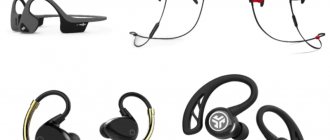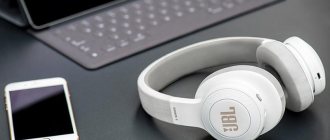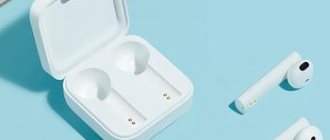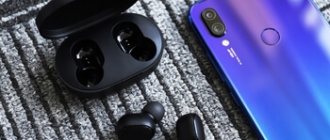The inexplicable ability of headphone wires to tangle in the user’s pocket into a tangle has already been the subject of many memes. When you take such a ball out of your pocket again, it’s wildly annoying. While untangling the wires in frustration, you can tug on one of them too hard and the headphones will end up in the trash.
Fortunately, manufacturers were able to offer an alternative to wired “plugs” - headphones-player. What are headphones with a player and what are their advantages and disadvantages, says a Sony Walkman WH505 user with 8 years of experience.
What are headphones-player?
Headphone-player is a predominantly closed-type gadget with a slot for a flash card. The ability to replace the memory card depends on the design features of the headphones. On some models it cannot be replaced without completely disassembling the gadget. In this case, you can only download new tracks and delete boring ones via a USB cable.
Tracks are controlled through keys and toggle switches located on the earcups. For example, after a short press on the toggle switch, the next song in the list starts playing, and after a long press, the next album in the list starts playing. You can also adjust the volume, activate another equalizer preset or Shuffle mode - play tracks in a random order.
Despite the fact that some users on the Internet claim that the player headphones sound bad, this is not the case. This “rumor” is the product of a “damaged phone”, and it is most actively spread by those who have had nothing to do with headphones with built-in players at all. In any case, the player headphones have a 3.5 mm jack, so you can connect them to your phone via an AUX cable.
Advantages and disadvantages
Here are a number of reasons why users love headphones with a built-in player:
- Long working time. For some reason, people are amazed when you tell them that the player headphones need to be charged once every 2 weeks. But this is actually true. If you charge the ears before the trip, you don’t have to take the power cable with you. On average, one charge lasts for 12 hours of music playback.
- No wires. Listening to headphones while jogging is pure pleasure. Running with a heavy 6-inch smartphone dangling in your shorts pocket is such a pastime.
- There is a radio. If you're tired of your playlist, you can switch to a trendy radio station and get acquainted with the latest music. However, not all players are equipped with an FM radio function.
Headphones with a player have features that manufacturers should think through more carefully:
- Track navigation. Finding the track you want to listen to in a playlist on your smartphone is as easy as shelling pears. But with headphones-player the situation is different. Using the switch you can go to the next/previous song or next/previous album. If there are 40 more tracks between the song you just listened to and the song you want to listen to next, you will have to press the switch 40 times.
- Weight. Player headphones are heavier than regular ones because they have a “filling” - a microprocessor, a flash drive, and a battery. On average, the weight is about 250-300 grams.
- Maintainability. Alas, for many models - including the Sony Walkman WH505 headphones, which the author absolutely adores - the flash drive cannot be removed. So, if the gadget suddenly fails, you will have to contact a service center for diagnostics. Although, perhaps, such a banal operation as replacing a memory card would allow the user to return the player to a working state without extra costs.
Rating
Manufacturers produce many models of sports devices. Some of them have wider functionality and high-quality assembly. We've ranked the best running players for 2022 based on customer ratings and reviews:
Sony NW-WS623
pros
- Lightweight body is almost not felt on the ears
- High quality plastic and assembly
- Sound quality is sufficient for active sports
- Has a fast charging function
Minuses
- Volume leaves much to be desired
- No carrying case included
From 7500 ₽
Waterproof headphones that can be used for swimming in fresh or salt water. They have a capacious battery with fast charging function. A few minutes of power is enough for a full hour of continuous playback. The body weight is only 32 grams, making the headphones almost unnoticeable while running.
Digma R3 8GB
pros
- Convenient control
- High sound quality
- Function to remember the last moment of playback
- Long battery life
Minuses
- Poor quality radio
From 1500 ₽
Sony NWZ-B183F
pros
- Stylish case design
- Convenient button placement
- Connects quickly to your computer using direct USB
- High sound quality
Minuses
- It's easy to lose the cap
From 3000 ₽
Bright blue player. It has a durable aluminum body with a glossy finish. Supports most popular music formats. There is a radio receiver with 30 fixed settings and recording capabilities.
Digma C2L 4GB
pros
- Affordable price
- Robust housing
- Good sound quality
- Holds charge for 10-12 hours of playback
Minuses
- Sometimes the forward/back buttons get confused
- Random mode works every other time
From 800 ₽
Sony NW-WS413
pros
- High quality waterproof housing
- Simple and intuitive controls
- Fast charging function
Minuses
- No radio
- Not enough bass
From 6000 ₽
Hybrid waterproof player with flashing capability. Maintains depth up to 2 meters even in sea water. The device is protected from dust and dirt, and also remains operational at high temperatures up to 45 degrees. One of the features is the ability to listen to surrounding sounds without removing the headphones.
What types of wireless headphones-player are there?
Depending on the design, player headphones are divided into full-size or closed-type (left) and sports (right).
In sports headphones, the emphasis is on compactness. They weigh like a feather, but sound rather mediocre. A person who is accustomed to the sound of full-size headphones will listen to sports headphones through pain. Note that sports headphones are not independent - they operate on a battery for 7-8 hours.
Full-size headphones usually have a phenomenal frequency range. Sony Walkman models, for example, transmit frequencies from 5 Hz to 25,000 Hz - and this despite the fact that a person hears a range of 16-20,000 Hz. You can run in closed-type headphones; their weight does not cause much discomfort when they are on your head. But if you want to take a break and listen to the sounds of the street while jogging, then hang them around your neck - then the cups will hit your chest unpleasantly.
Closed-back player headphones are a rather fragile thing. We recommend that you protect your gadget from falls and impacts in every possible way. Sports headphones, on the other hand, are durable.
Player headphones are also classified according to the presence of FM radio, Bluetooth support, and degree of protection from water. However, these functions are perhaps self-explanatory.
FAQ
What is IPX?
IP, IPX and IPXY designations indicate how protected a particular device is from dust and moisture. “X” is responsible for dust protection (the first digit after the IP marking), and the second digit “Y” indicates the level of protection against moisture.
For sports, IPX4 protection is enough - this means that the headphones will not be damaged by sweat. But in order for them to truly withstand immersion in water, they must be IPX7 rated and specially designed.
Can I use regular headphones for sports?
In theory, regular headphones are suitable for this use. However, they can cause inconvenience because during active training they can fall out of the ears or fall off the head. And if they do not claim protection from moisture, they will quickly fail under the influence of sweat.
Why do some headphones come with several ear pads?
If the set includes ear pads of different sizes, then this is a good way to choose the optimal fit for yourself, because everyone's ears are different. Ear pads that are too small will cause some people to fall out, while ear pads that are too large will cause discomfort. Of the 3-4 options, you have a better chance of choosing your size.
Topic materials: 5 best DJ headphones
5 Best Bluedio Headphones
5 Best Creative Headphones
5 Best Headphones for Kids
5 Best Foldable Headphones
6 Best Headphones for Sleeping
, 7 Best JBL Wireless Headphones , 7 Best In-Ear Headphones
, 7 best earbuds
How to choose headphones with a player?
A person who is not demanding on sound quality and who, for example, listens to music to concentrate on work, can afford to choose headphones based on their appearance. But a music lover needs to understand the technical characteristics and choose headphones based on them. Otherwise, an expensive purchase may result in disappointment.
What you should definitely look for:
- Sensitivity. Contrary to popular belief, it is sensitivity that determines the volume of headphones, not power. The norm is a “corridor” of 90-120 dB.
- Impedance. Impedance (resistance) is the inverse parameter of sensitivity. For headphones, the norm is 16-40 dB, the average value is 32 dB.
- Power. The power value is not the most important thing now, because modern headphones have amplifiers. Thanks to amplifiers, even with minimal power you can get decent sound. Here we recommend focusing on a wide “corridor” of values – 50-100 mW.
- Frequency range. The frequency range of 20-20000 Hz is sufficient. A person hears lower frequencies only under ideal conditions and up to a certain age.
- Memory size. You can ignore this parameter if the headphone player has the ability to replace a flash drive. If not, it’s better to go with 16 GB. However, your music lover author failed to fill this volume even halfway.
- Autonomy. The operating time of the models is very different: some work 40 hours without recharging, others only 7. It’s difficult to advise anything here, because it’s important to imagine how often and for how long a music lover listens to music. Autonomy of 20 hours is more than a decent indicator. You can listen to headphones for an hour a day for 3 weeks. By the way, when turned off, they almost do not lose charge.
- Weight. Closed-back headphones should weigh up to 300 grams so that you can use them without discomfort. Sports headphones typically weigh about 30 grams.
Design is also important. It was love at first sight for the author of this article with the Walkman WH505 model - it was impossible not to fall in love with the headphones placed on a special Sony branded stand with backlight. For its excellent design, the Japanese player would have to forgive shortcomings in sound - if they existed, of course.
Criterias of choice
There are several important nuances that you should pay attention to when choosing a sports player:
- Case size. A sports player should be light and compact, so it is preferable to choose devices with flash memory. They are not afraid of sudden movements and consume little electricity.
- Playback quality. As mentioned earlier, running players have a flatter sound than regular models. This is due to less functionality, lack of an equalizer and a good amplifier. Before purchasing, it is better to evaluate the sound of the device yourself.
- Fastening. The player for jogging can be attached to the neck, on clothing, on the forearm or placed on the ears. It is better to determine in advance which type of fastening is right for you.
- Memory. The optimal amount of memory for a sports device is considered to be from 1 to 8 GB. The number of music tracks depends on how often you use the player. For a short everyday workout, one playlist may be enough, but for regular long-term workouts it is better to purchase a model with more space. Keep in mind that 1 GB is approximately 100-150 songs.
- Waterproof. A slight degree of water resistance is useful for any player. This will protect you from rain or snow. If you plan to use the player in a pool, then the moisture protection level must be at least IPx
- Additional functions. To track your results, you should get a device that can count calories and distance traveled. Also useful features are a heart rate monitor and a blood pressure monitor.
- Battery life. The battery charge should be enough for 4-8 hours of battery life. These are optimal indicators for all sports models.
When purchasing, you should pay attention to the integrity of the device and the absence of external damage. Make sure it comes with a cable or a separate charging brick. If the device is waterproof, suitable headphones must be used with it.











